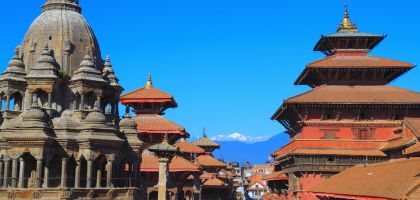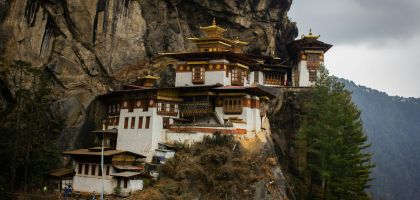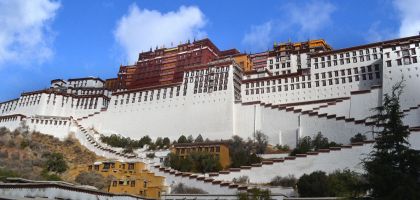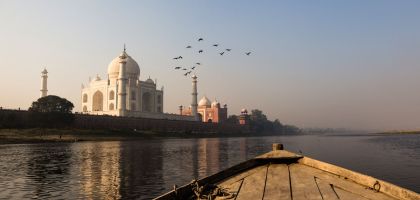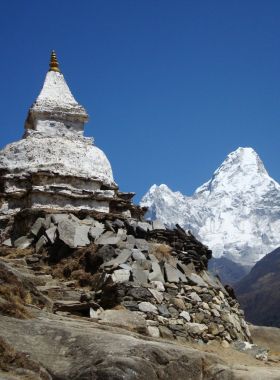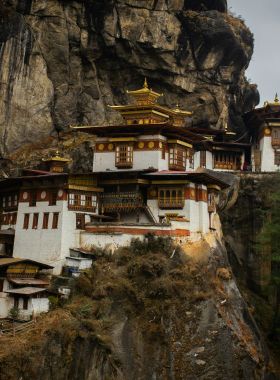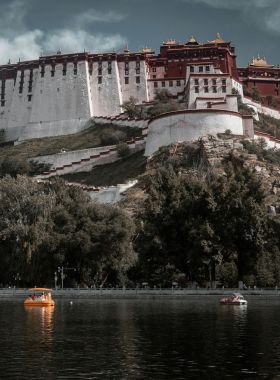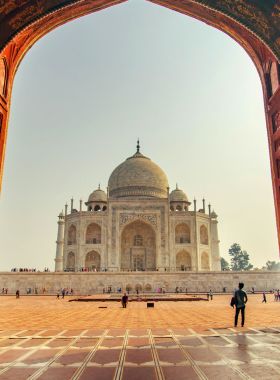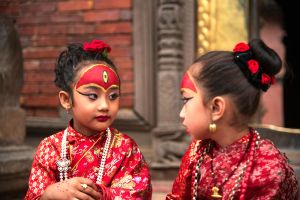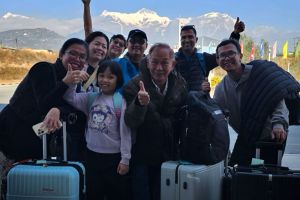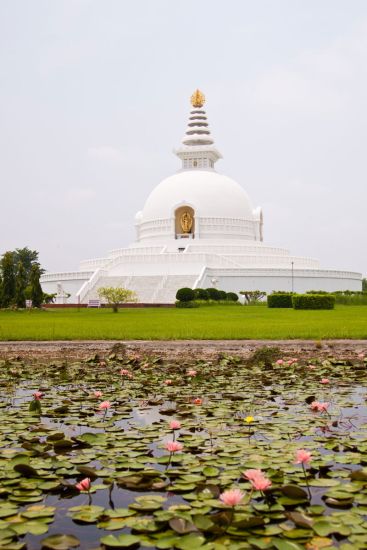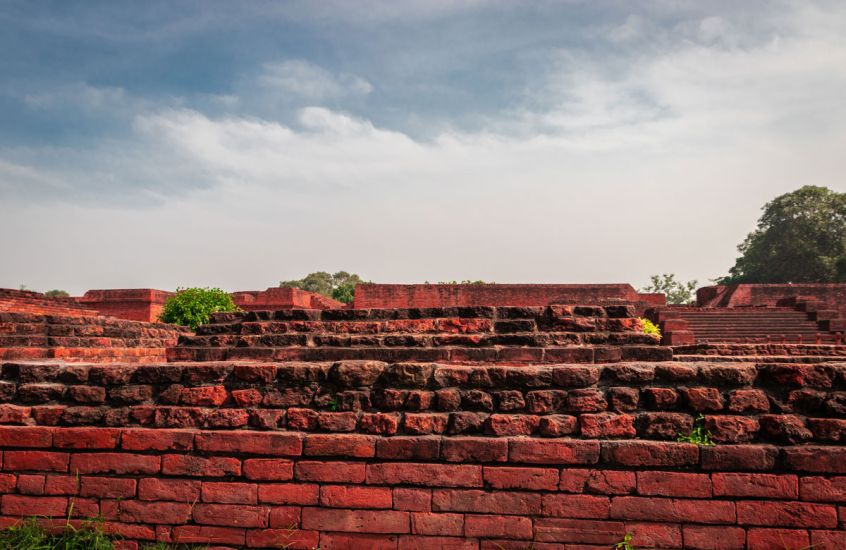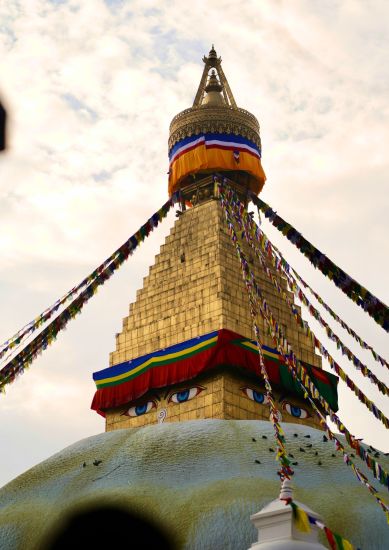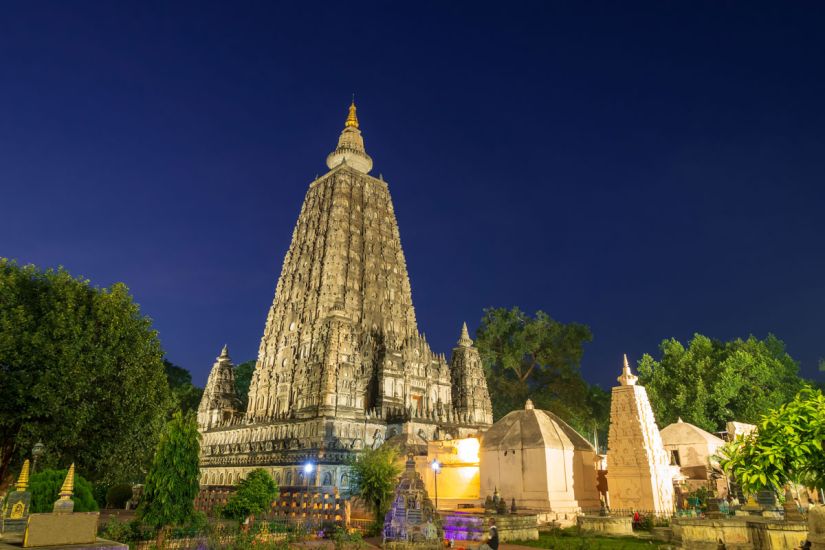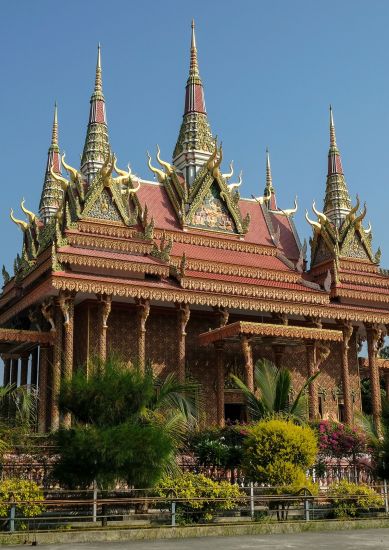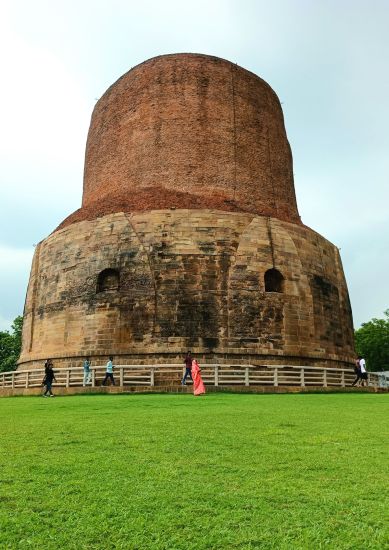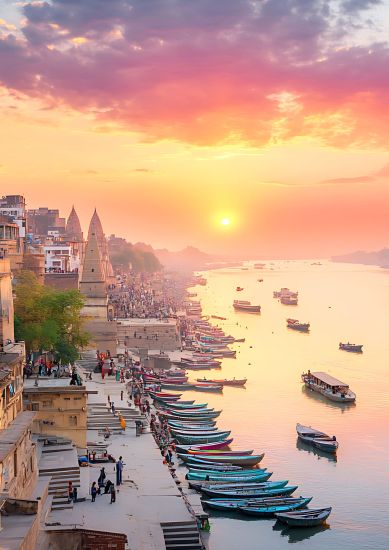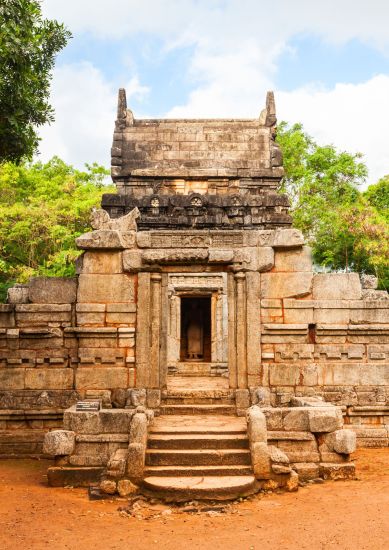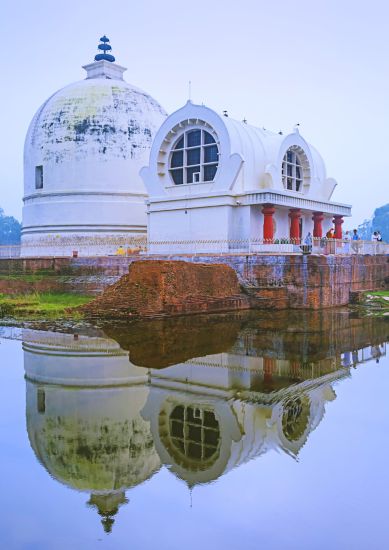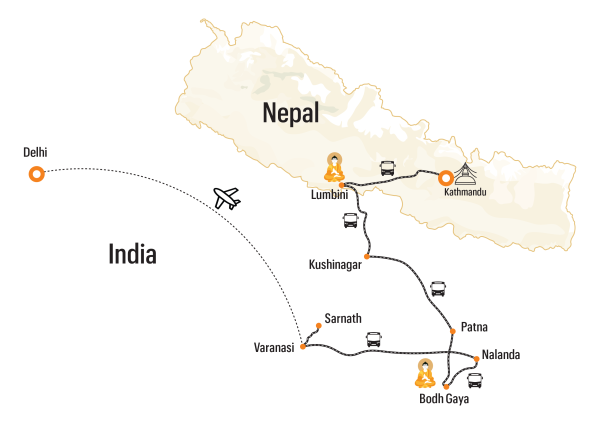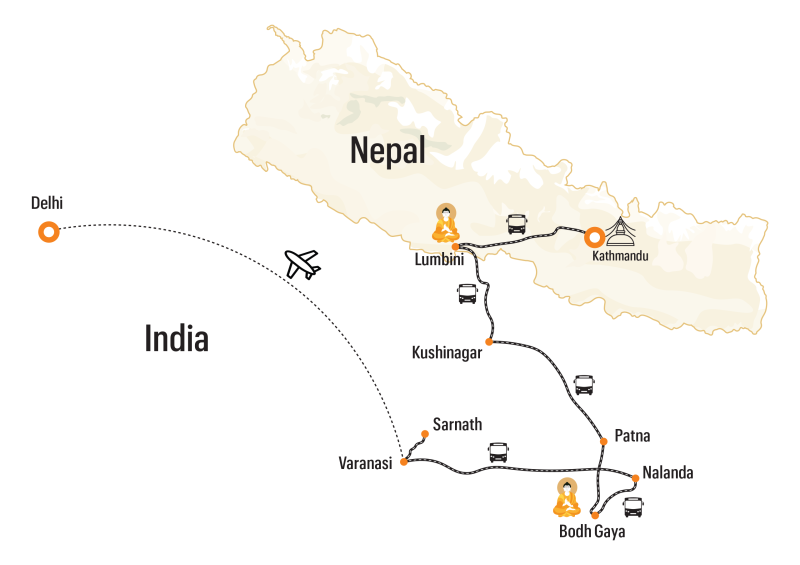Buddhist Tour – Nepal & India
13 Days / Cross Border Tours
Activity
Difficulty Level
Destinations
Trip Start / End
Accommodation
Travel Style
Best time to travel
Personalized Travel Advice

Dev Raj Nepal
+977 9851096523
Personalized Travel Advice

Dev Raj Nepal
+977 9851096523
Detailed Itinerary
01
DAY
01
Your Buddhist Tour in Nepal and India begins with your arrival at Tribhuvan International Airport, Kathmandu. You will be greeted by us and transferred to the hotel. After checking in and settling down, the rest of the day is at your leisure. You can relax and recover from your flight, or perhaps take a short stroll around the local area. In the evening, enjoy a warm welcome dinner at a traditional Nepalese restaurant, where you’ll get a taste of Nepal’s traditional cuisine. Overnight in Kathmandu.
Arrival – Kathmandu
Your Buddhist Tour in Nepal and India begins with your arrival at Tribhuvan International Airport, Kathmandu. You will be greeted by us and transferred to the hotel. After checking in and settling down, the rest of the day is at your leisure. You can relax and recover from your flight, or perhaps take a short stroll around the local area. In the evening, enjoy a warm welcome dinner at a traditional Nepalese restaurant, where you’ll get a taste of Nepal’s traditional cuisine. Overnight in Kathmandu.
02
DAY
02
After a pleasant breakfast, start your Buddhist tour of Nepal and India, in Kathmandu with a first stop at Boudhanath Stupa. This monumental Buddhist shrine boasts a massive white dome crowned by a gilded spire and the all‑seeing eyes of the Buddha. Your guide will inform you the symbolism of the shrine and it’s architecture. It’s one of the largest spherical stupas in the world and serves as a vibrant spiritual hub for Tibetan Buddhism, surrounded by monasteries, shops, cafés and prayer wheels. Walking around its circular platform, visitors often join pilgrims chanting the mantra Om Mani Padme Hum in a clockwise “kora.” Expect a calm, reflective atmosphere mixed with everyday religious life.
Next, drive south of Kathmandu to Pharping, a peace‑filled town perched on the valley rim. Here, the scenery quiets down and nature blends with devotion. The key attraction is the sacred cave of Yanglesho (also called Asura Cave) where the revered master Padmasambhava (also known as Guru Rinpoche) is said to have attained spiritual power. The site draws Buddhists seeking retreat and reflection. Besides the cave, one can visit the 17th‑century Vajrayogini temple and wander among peaceful monasteries overlooking the hills. This stop offers a contrast to the bustle of the city and invites a slower pace.
Finally, return to Kathmandu for the hilltop visit to Swayambhunath, often known as the “Monkey Temple”. Situated on a wooded rise above the city, the stupa with its white dome and golden spire commands views across the valley. Visitors climb a steep staircase or approach via road, arriving into a complex of shrines, temples, prayer wheels—and curious macaque monkeys roaming freely.
Kathmandu Exploration
After a pleasant breakfast, start your Buddhist tour of Nepal and India, in Kathmandu with a first stop at Boudhanath Stupa. This monumental Buddhist shrine boasts a massive white dome crowned by a gilded spire and the all‑seeing eyes of the Buddha. Your guide will inform you the symbolism of the shrine and it’s architecture. It’s one of the largest spherical stupas in the world and serves as a vibrant spiritual hub for Tibetan Buddhism, surrounded by monasteries, shops, cafés and prayer wheels. Walking around its circular platform, visitors often join pilgrims chanting the mantra Om Mani Padme Hum in a clockwise “kora.” Expect a calm, reflective atmosphere mixed with everyday religious life.
Next, drive south of Kathmandu to Pharping, a peace‑filled town perched on the valley rim. Here, the scenery quiets down and nature blends with devotion. The key attraction is the sacred cave of Yanglesho (also called Asura Cave) where the revered master Padmasambhava (also known as Guru Rinpoche) is said to have attained spiritual power. The site draws Buddhists seeking retreat and reflection. Besides the cave, one can visit the 17th‑century Vajrayogini temple and wander among peaceful monasteries overlooking the hills. This stop offers a contrast to the bustle of the city and invites a slower pace.
Finally, return to Kathmandu for the hilltop visit to Swayambhunath, often known as the “Monkey Temple”. Situated on a wooded rise above the city, the stupa with its white dome and golden spire commands views across the valley. Visitors climb a steep staircase or approach via road, arriving into a complex of shrines, temples, prayer wheels—and curious macaque monkeys roaming freely.
03
DAY
03
As part of the Buddhist Tour of Nepal and India, early morning after breakfast, you board a domestic flight from Kathmandu to Gautam Buddha Airport (Bhairawa), the quick 40 minute hop down into the southern plains. From the airport you take a short drive to Lumbini, where the air warms and the landscape opens into Terai flatlands.
Arriving in Lumbini, you begin in the Monastic Zone: wander among the peaceful courtyards of various international monasteries representing Buddhist traditions from around the world, each with distinctive architecture and quiet gardens. You then stroll through the sacred complex of Lumbini, birthplace of Siddhartha Gautama (Buddha), where the atmosphere invites quiet reflection and a sense of deep history.
Next, explore the surrounding Monastic Zone which expands the experience, the tranquil walking paths lead you past temple facades, meditation halls, and lush lawns, offering a serene contrast to the bustle of a city‑tour day.
Stay overnight at a hotel in Lumbini.
Kathmandu – Lumbini
As part of the Buddhist Tour of Nepal and India, early morning after breakfast, you board a domestic flight from Kathmandu to Gautam Buddha Airport (Bhairawa), the quick 40 minute hop down into the southern plains. From the airport you take a short drive to Lumbini, where the air warms and the landscape opens into Terai flatlands.
Arriving in Lumbini, you begin in the Monastic Zone: wander among the peaceful courtyards of various international monasteries representing Buddhist traditions from around the world, each with distinctive architecture and quiet gardens. You then stroll through the sacred complex of Lumbini, birthplace of Siddhartha Gautama (Buddha), where the atmosphere invites quiet reflection and a sense of deep history.
Next, explore the surrounding Monastic Zone which expands the experience, the tranquil walking paths lead you past temple facades, meditation halls, and lush lawns, offering a serene contrast to the bustle of a city‑tour day.
Stay overnight at a hotel in Lumbini.
04
DAY
04
A Buddhist tour is not complete without a visit to Lumbini, the birth place of the Buddha. Lumbini, a UNESCO World Heritage Site, is a sacred destination of immense archaeological and religious significance. In the morning, you will visit the renowned Maya Devi Temple, the spiritual heart of Lumbini, which marks the exact spot where Queen Maya Devi gave birth to Siddhartha Gautam, the Buddha. You’ll stand before the sacred Bodhi Tree, under which Siddhartha is said to have meditated. The nearby Ashoka Pillar, erected by Emperor Ashoka in 249 BC, commemorates the birthplace of Buddha and features the oldest inscription in Nepal. You will also explore the ancient Bathing Pond, where pilgrims have bathed for centuries as part of their spiritual practice. Alongside these historical sites, you will visit the Lumbini Museum, which displays artifacts that trace the history of the area, and the Peace Pagoda, offering a serene space for reflection. As you walk through the peaceful grounds, you will experience the tranquil atmosphere created by pilgrims chanting and meditating from dawn to dusk.
In the afternoon, you will drive approximately 29km west to Tilaurakot, the historical site of Kapilavastu, where Siddhartha Gautam spent the first 29 years of his life. As you explore the site, you’ll see the remains of ancient structures, and wander through the peaceful meadow that sits alongside the Banganga River. You will visit the striking shrine dedicated to Maya Devi, adorned with intricate carvings of elephants. A small museum at the site showcases significant artifacts uncovered during excavations, offering deeper insight into the area’s rich history. After immersing yourself in the historical and spiritual significance of Kapilavastu, you will return to Lumbini for the evening, reflecting on the powerful experiences of the day. Overnight in Lumbini.
Lumbini & Kapilvastu Exploration
A Buddhist tour is not complete without a visit to Lumbini, the birth place of the Buddha. Lumbini, a UNESCO World Heritage Site, is a sacred destination of immense archaeological and religious significance. In the morning, you will visit the renowned Maya Devi Temple, the spiritual heart of Lumbini, which marks the exact spot where Queen Maya Devi gave birth to Siddhartha Gautam, the Buddha. You’ll stand before the sacred Bodhi Tree, under which Siddhartha is said to have meditated. The nearby Ashoka Pillar, erected by Emperor Ashoka in 249 BC, commemorates the birthplace of Buddha and features the oldest inscription in Nepal. You will also explore the ancient Bathing Pond, where pilgrims have bathed for centuries as part of their spiritual practice. Alongside these historical sites, you will visit the Lumbini Museum, which displays artifacts that trace the history of the area, and the Peace Pagoda, offering a serene space for reflection. As you walk through the peaceful grounds, you will experience the tranquil atmosphere created by pilgrims chanting and meditating from dawn to dusk.
In the afternoon, you will drive approximately 29km west to Tilaurakot, the historical site of Kapilavastu, where Siddhartha Gautam spent the first 29 years of his life. As you explore the site, you’ll see the remains of ancient structures, and wander through the peaceful meadow that sits alongside the Banganga River. You will visit the striking shrine dedicated to Maya Devi, adorned with intricate carvings of elephants. A small museum at the site showcases significant artifacts uncovered during excavations, offering deeper insight into the area’s rich history. After immersing yourself in the historical and spiritual significance of Kapilavastu, you will return to Lumbini for the evening, reflecting on the powerful experiences of the day. Overnight in Lumbini.
05
DAY
05
After an early breakfast, travel from Lumbini to Sunauli, the border town between Nepal and India. Cross into Uttar Pradesh, India, where your journey continues to Kushinagar, one of the most important sites for Buddhist pilgrims. Kushinagar is where Buddha attained Mahaparinirvana or the final nirvana after his death. Visit the Mahaparinirvana Temple, which houses the iconic reclining Buddha statue, symbolizing the peaceful passing of Buddha. Spend time in the tranquil surroundings of this sacred site, reflecting on its deep spiritual significance. Stay overnight in Kushinagar.
Lumbini – Sunauli – Kushinagar
After an early breakfast, travel from Lumbini to Sunauli, the border town between Nepal and India. Cross into Uttar Pradesh, India, where your journey continues to Kushinagar, one of the most important sites for Buddhist pilgrims. Kushinagar is where Buddha attained Mahaparinirvana or the final nirvana after his death. Visit the Mahaparinirvana Temple, which houses the iconic reclining Buddha statue, symbolizing the peaceful passing of Buddha. Spend time in the tranquil surroundings of this sacred site, reflecting on its deep spiritual significance. Stay overnight in Kushinagar.
06
DAY
06
After breakfast, set off for a drive to Patna, the capital city of Bihar. The journey will take several hours, but the scenic route offers glimpses into rural India and the Ganges River. Upon arrival in Patna, check in to your hotel and enjoy the evening at your leisure. You may choose to explore the local markets or simply relax at your hotel.
Overnight in Patna.
Kushinagar – Patna
After breakfast, set off for a drive to Patna, the capital city of Bihar. The journey will take several hours, but the scenic route offers glimpses into rural India and the Ganges River. Upon arrival in Patna, check in to your hotel and enjoy the evening at your leisure. You may choose to explore the local markets or simply relax at your hotel.
Overnight in Patna.
07
DAY
07
Today, after breakfast, drive to Bodhgaya, a place of immense spiritual importance. Bodhgaya is where Lord Buddha achieved enlightenment under the Bodhi Tree. Visit the Mahabodhi Temple, a UNESCO World Heritage site that is home to the very tree where Buddha meditated. The temple is a peaceful haven for reflection and meditation, attracting pilgrims from around the world. Take some time to absorb the serene atmosphere and gain spiritual insight in this sacred location. Overnight in Bodhgaya.
Patna – Bodhgaya
Today, after breakfast, drive to Bodhgaya, a place of immense spiritual importance. Bodhgaya is where Lord Buddha achieved enlightenment under the Bodhi Tree. Visit the Mahabodhi Temple, a UNESCO World Heritage site that is home to the very tree where Buddha meditated. The temple is a peaceful haven for reflection and meditation, attracting pilgrims from around the world. Take some time to absorb the serene atmosphere and gain spiritual insight in this sacred location. Overnight in Bodhgaya.
08
DAY
08
After breakfast, embark on a full day of spiritual and cultural exploration in Bodhgaya, one of the holiest sites in Buddhism. Begin your journey at the Mahabodhi Temple, a UNESCO World Heritage Site, where the Buddha attained enlightenment. Admire its stunning architecture and the revered Bodhi Tree, under which Siddhartha Gautama meditated and found enlightenment. The sacred grounds invite deep reflection, and you’ll have time to meditate or simply absorb the peaceful ambiance.
Next, visit the towering Great Buddha Statue, an awe-inspiring monument that stands at 80 feet tall. Take in the serenity and the impressive views surrounding the statue, which holds great significance for Buddhists worldwide.
Stroll over to the nearby Thai Temple, an architectural gem reflecting Thai Buddhist traditions. The temple offers a tranquil space for quiet contemplation. As you wander around the area, you’ll discover a variety of monasteries and temples representing different Buddhist countries, including the Japanese Temple, the Tibetan Monastery, and the Vietnamese Temple, each showcasing unique styles and spiritual practices.
Take time to immerse yourself in the beautiful gardens surrounding these sacred sites, where you can enjoy moments of peaceful solitude or engage in quiet meditation. The atmosphere in Bodhgaya is deeply spiritual, offering a unique opportunity for personal reflection and rejuvenation on Buddha’s path to enlightenment. After an enriching day, return to your hotel for an overnight stay.
Bodhgaya Exploration
After breakfast, embark on a full day of spiritual and cultural exploration in Bodhgaya, one of the holiest sites in Buddhism. Begin your journey at the Mahabodhi Temple, a UNESCO World Heritage Site, where the Buddha attained enlightenment. Admire its stunning architecture and the revered Bodhi Tree, under which Siddhartha Gautama meditated and found enlightenment. The sacred grounds invite deep reflection, and you’ll have time to meditate or simply absorb the peaceful ambiance.
Next, visit the towering Great Buddha Statue, an awe-inspiring monument that stands at 80 feet tall. Take in the serenity and the impressive views surrounding the statue, which holds great significance for Buddhists worldwide.
Stroll over to the nearby Thai Temple, an architectural gem reflecting Thai Buddhist traditions. The temple offers a tranquil space for quiet contemplation. As you wander around the area, you’ll discover a variety of monasteries and temples representing different Buddhist countries, including the Japanese Temple, the Tibetan Monastery, and the Vietnamese Temple, each showcasing unique styles and spiritual practices.
Take time to immerse yourself in the beautiful gardens surrounding these sacred sites, where you can enjoy moments of peaceful solitude or engage in quiet meditation. The atmosphere in Bodhgaya is deeply spiritual, offering a unique opportunity for personal reflection and rejuvenation on Buddha’s path to enlightenment. After an enriching day, return to your hotel for an overnight stay.
09
DAY
09
Take a day trip to Nalanda, the ancient center of learning that once attracted students from all over Asia. Explore the ruins of the university, which housed thousands of monks and scholars. Visit the Nalanda Archaeological Museum, which displays artifacts from the time when Nalanda was at the height of its glory. After a full day of exploration, return to Bodhgaya for a relaxing evening. Overnight in Bodhgaya.
Bodhgaya – Nalanda Excursion
Take a day trip to Nalanda, the ancient center of learning that once attracted students from all over Asia. Explore the ruins of the university, which housed thousands of monks and scholars. Visit the Nalanda Archaeological Museum, which displays artifacts from the time when Nalanda was at the height of its glory. After a full day of exploration, return to Bodhgaya for a relaxing evening. Overnight in Bodhgaya.
10
DAY
10
After breakfast, drive to Varanasi, one of the oldest living cities in the world and a key destination for Hindu pilgrims. Upon arrival, check-in at your hotel, and in the evening, witness the Ganga Aarti at Dashashwamedh Ghat, where devotees gather to offer prayers and light lamps in the holy Ganges River. The sight of the ritual being performed at sunset is an unforgettable experience. Overnight in Varanasi.
Bodhgaya – Varanasi
After breakfast, drive to Varanasi, one of the oldest living cities in the world and a key destination for Hindu pilgrims. Upon arrival, check-in at your hotel, and in the evening, witness the Ganga Aarti at Dashashwamedh Ghat, where devotees gather to offer prayers and light lamps in the holy Ganges River. The sight of the ritual being performed at sunset is an unforgettable experience. Overnight in Varanasi.
11
DAY
11
After breakfast, enjoy a short drive to Sarnath, one of the most sacred sites for Buddhists. It was here that Buddha delivered his first sermon after attaining enlightenment, known as the Dhammacakkappavattana Sutta—the “Turning of the Wheel of Dharma.” Begin your visit at the Dhamek Stupa, an impressive monument that marks the site where Buddha preached to his first five disciples. The stupa, standing at 43 meters tall, is an architectural marvel, adorned with intricate carvings depicting scenes from Buddha’s life and teachings.
Next, head to the Archaeological Museum, home to an invaluable collection of relics from ancient Buddhist sites, including sculptures, inscriptions, and Buddhist art that offer insights into the region’s rich history. The museum’s artifacts are a fascinating testament to the ancient civilization that flourished here.
Explore the Sarnath Monastery, a peaceful and serene place where you can sit in quiet reflection or prayer. The monastery complex, with its beautiful gardens and tranquil atmosphere, is a perfect spot to experience the spiritual significance of Sarnath.
Take some time to wander the lush grounds and meditate under the shade of trees, surrounded by the sights and sounds of nature. Sarnath is not only a significant historical site but also a place of profound spiritual meaning for Buddhists worldwide. Return to Varanasi in the evening. Stay overnight at Varanasi.
Varanasi – Sarnath Excursion
After breakfast, enjoy a short drive to Sarnath, one of the most sacred sites for Buddhists. It was here that Buddha delivered his first sermon after attaining enlightenment, known as the Dhammacakkappavattana Sutta—the “Turning of the Wheel of Dharma.” Begin your visit at the Dhamek Stupa, an impressive monument that marks the site where Buddha preached to his first five disciples. The stupa, standing at 43 meters tall, is an architectural marvel, adorned with intricate carvings depicting scenes from Buddha’s life and teachings.
Next, head to the Archaeological Museum, home to an invaluable collection of relics from ancient Buddhist sites, including sculptures, inscriptions, and Buddhist art that offer insights into the region’s rich history. The museum’s artifacts are a fascinating testament to the ancient civilization that flourished here.
Explore the Sarnath Monastery, a peaceful and serene place where you can sit in quiet reflection or prayer. The monastery complex, with its beautiful gardens and tranquil atmosphere, is a perfect spot to experience the spiritual significance of Sarnath.
Take some time to wander the lush grounds and meditate under the shade of trees, surrounded by the sights and sounds of nature. Sarnath is not only a significant historical site but also a place of profound spiritual meaning for Buddhists worldwide. Return to Varanasi in the evening. Stay overnight at Varanasi.
12
DAY
12
After breakfast, enjoy some free time in Varanasi for last-minute sightseeing, shopping, or personal exploration. Later in the afternoon, take a flight from Varanasi to Delhi, India’s bustling capital. Upon arrival in Delhi, transfer to your hotel and settle in for the evening.
Overnight in Delhi.
Varanasi – Delhi
After breakfast, enjoy some free time in Varanasi for last-minute sightseeing, shopping, or personal exploration. Later in the afternoon, take a flight from Varanasi to Delhi, India’s bustling capital. Upon arrival in Delhi, transfer to your hotel and settle in for the evening.
Overnight in Delhi.
13
DAY
13
Your Buddhist Circuit tour of Nepal and India ends today. On the final day of your journey, you will be transferred to the airport for your departure flight, concluding this spiritual and cultural tour through some of the most important Buddhist sites in the world.
Delhi – Departure
Your Buddhist Circuit tour of Nepal and India ends today. On the final day of your journey, you will be transferred to the airport for your departure flight, concluding this spiritual and cultural tour through some of the most important Buddhist sites in the world.
Tour Cost
At High Asia Tours, we know that understanding tour costs is essential for planning your trip. Due to variables such as accommodation choices, meal plans, transportation options, group size, and seasonal demand, providing an exact price upfront is challenging.
To assist you, we offer a starting price to give a general idea of the cost:
The starting cost for this tour is
Includes / Excludes
Inclusions
-
Accommodation based on double/twin sharing
-
Meals mentioned in the itinerary
-
Private vehicle with experienced driver for all transfers
-
English-speaking local guides for city tours and excursions.
-
All entrance fees to temples, historical sites, and museums as per the itinerary.
-
Flight from Kathmandu to Lumbini.
-
Flight from Varanasi to Delhi.
-
All applicable government taxes and service charges.
Exclusions
-
International Flights
-
Visa Fees
-
Personal items such as laundry, shopping, snacks, or beverages outside of the provided meals.
-
Travel insurance covering medical emergencies, trip cancellations, etc.
-
Tips for drivers, guides, and hotel staff.
-
Any optional tours or activities not mentioned in the itinerary.
-
Any meals not specifically mentioned as included.
Trip Info
Buddhism traces its roots to the heart of South Asia, with Nepal and India holding the most significant sites in the life of Lord Buddha. From the serene birthplace in Lumbini, Nepal, to the place of enlightenment in Bodh Gaya, India, and the sites of teaching and final passing, these lands offer a profound spiritual journey for pilgrims, history enthusiasts, and cultural travelers alike. This Buddhist Tour with take you to most of the places that mark that Buddha and his followers once took.
Origins of Buddhism in Nepal
Nepal is the birthplace of Siddhartha Gautama, who became the Buddha. Lumbini, located in the Terai region, is a UNESCO World Heritage Site featuring the sacred Maya Devi Temple, ancient Ashokan Pillar, and monastic zones built by countries across Asia. Nearby, Kapilvastu offers a glimpse into the early life of Prince Siddhartha, with ruins and sites reflecting the prince’s childhood and formative years.
Buddhist Heritage Across India
India is where Siddhartha attained enlightenment and became the Buddha, shared his teachings, and reached Mahaparinirvana. Key sites include:
Bodh Gaya: The place of enlightenment, with the iconic Mahabodhi Temple and the sacred Bodhi Tree, attracting pilgrims from around the world.
Sarnath: Where Buddha delivered his first sermon, featuring the Dhamek Stupa and ancient monasteries.
Kushinagar: The site of Buddha’s Mahaparinirvana, with stupas and serene meditation spaces.
Nalanda: The ancient center of learning, reflecting centuries of Buddhist scholarship and education.
Varanasi: Though primarily a Hindu holy city, nearby Sarnath connects visitors to the Buddhist teachings.
Cultural and Spiritual Significance
Buddhism in Nepal and India is about history and also about living traditions. Monasteries, meditation centers, and rituals keep the teachings alive. Pilgrims witness monks performing ceremonies, explore vibrant festivals, and experience the tranquility of prayer halls and stupas. Local cuisine, handicrafts, and architecture further enrich this cultural journey.
Modern Pilgrimage Experiences
Today, travelers can follow the Buddhist Tour of Nepal and India, connecting all major sites in a seamless journey. From Kathmandu’s Buddhist shrines to Lumbini, Bodh Gaya, and Sarnath, this route allows for reflection, learning, and spiritual growth while exploring centuries-old heritage.
Why Visit Nepal and India for Buddhism?
- Walk in the footsteps of the Buddha across sacred landscapes.
- Experience the diversity of Buddhist architecture and monastic traditions.
- Engage in meditation, rituals, and cultural activities with local communities.
- Witness UNESCO World Heritage Sites and ancient centers of learning.
Buddhist Tour in Nepal and India
This Buddhist Tour is a journey tracing the life, teachings, and legacy of Lord Buddha across Nepal and India. From his birthplace in Lumbini to his enlightenment in Bodh Gaya, the first sermon at Sarnath, and final Mahaparinirvana in Kushinagar, this tour immerses travelers in history, philosophy, and living traditions of Buddhism.
Footsteps of Buddha
This Buddhist Tour in Nepal and India allows travelers to walk in the footsteps of Buddha, experiencing the landscapes, temples, and monasteries that shaped his life. Each site offers insight into his journey from prince to enlightened teacher, giving a profound understanding of Buddhist philosophy and the quest for inner peace.
Buddhist Traditions – Mahayana, Theravada, and Vajrayana
Nepal and India are home to the three main traditions of Buddhism:
-
Theravada: Predominant in Lumbini and southern India, focusing on the original teachings of Buddha, meditation, and monastic discipline.
-
Mahayana: Visible in major monasteries and stupas, emphasizing compassion, the Bodhisattva ideal, and philosophical depth.
-
Vajrayana: Particularly in Nepal, where Himalayan influence blends ritual, symbolism, and meditation practices into colorful monastic traditions.
Visitors experience these traditions through monastic rituals, meditation sessions, and teachings, witnessing how Buddhism has evolved while preserving its essence.
Monks, Monasteries, and Spiritual Life
This Buddhist Tour in Nepal and India offers intimate encounters with monks and nuns in active monasteries. You will see daily rituals, chanting, meditation practices, and community life that sustain spiritual teachings. From the simple elegance of Theravada monks in Lumbini to the ornate Vajrayana monasteries in Nepal, every visit highlights dedication, discipline, and devotion.
History and Architecture
Buddhist heritage is a living museum of history and architecture. The Mahabodhi Temple in Bodh Gaya, a UNESCO World Heritage Site, showcases stunning stone carvings and intricate architectural design. Stupas in Sarnath, Kushinagar, and Lumbini reveal regional variations while conveying universal Buddhist principles. Ancient monasteries, pillars, and prayer halls tell stories of kings, emperors, and devotees who preserved these sacred sites for centuries.
Principles of Buddhism in Practice
Beyond monuments, this Buddhist tour in Nepal and India allows travelers to engage with core Buddhist principles: mindfulness, compassion, non-violence, and meditation. From walking through serene gardens in Lumbini to observing daily prayers in Sarnath, visitors gain a living experience of Buddhist teachings.
Cultural and Pilgrimage Experience
This Nepal and India Buddhist tour is historical and also deeply cultural. Guests witness prayers in monasteries, traditional crafts, and regional cuisine inspired by Buddhist practices. Interactions with local communities and monks enrich understanding of how Buddhism shapes daily life in Nepal and India.
The best time to do this Buddhist Tour in Nepal and India are:
Spring (March to May): This season offers mild and pleasant weather, with temperatures ranging from 10°C to 25°C (50°F to 77°F), perfect for sightseeing and spiritual exploration. The landscape comes alive with vibrant greenery, and flowers begin to bloom, creating a refreshing atmosphere that enhances the experience at sacred Buddhist sites.
Autumn (September to November): This is an equally enchanting season for the Buddhist Circuit Tour, with temperatures between 10°C to 22°C (50°F to 72°F). The weather remains crisp and clear, offering stunning views of the surrounding landscapes. The autumn months bring fewer crowds, allowing for a more serene and contemplative experience at the historical sites.
Winter (December to February): This season offers a more serene and peaceful atmosphere for the Buddhist Circuit Tour, with temperatures ranging from 5°C to 20°C (41°F to 68°F). While the weather can be chilly, especially in the mornings and evenings, the crisp air and clear skies provide a unique and tranquil experience at the sacred sites. The winter months attract fewer tourists, allowing for a quieter, more personal pilgrimage.
For this tour, we provide a variety of vehicles to ensure comfort and convenience, depending on the group size. For smaller groups of up to 3 people, we offer comfortable SUVs or sedans, perfect for a more personalized travel experience. For larger groups with more than 3 participants, we provide a minibus, ensuring ample space for everyone to relax during the journey. All our vehicles are well-maintained, equipped with air conditioning, and driven by experienced, professional chauffeurs to guarantee a smooth and enjoyable ride throughout your Buddhist Tour in Nepal and India.
For this Buddhist Tour in Nepal and India, we ensure that your stay is as comfortable and enriching as your journey. Accommodations range from well-appointed 3-star to 4-star hotels, providing a blend of modern amenities and local charm. Each hotel is carefully selected for its cleanliness, comfort, and proximity to key Buddhist sites, allowing you to relax and reflect after a day of exploration. Rooms are equipped with essential facilities such as air conditioning, hot water, and Wi-Fi, ensuring a restful stay. Some accommodations may also offer additional services such as meditation spaces or serene gardens, enhancing the spiritual experience of your tour. Whether you are unwinding in the heart of a bustling city or enjoying a peaceful retreat near sacred landmarks, your comfort is our priority.
During the Buddhist Tour in Nepal and India, you will have the opportunity to enjoy a mix of authentic local dishes and familiar Western food. Breakfasts, typically served at the hotels, include a range of continental and local options to cater to all tastes.
For lunch and dinner, traditional Indian and Nepali meals such as dal, roti, and vegetable curries will be offered. Vegetarian meals are widely available, and special dietary requirements can be accommodated.
For those who prefer Western cuisine, most hotels and restaurants along the route offer familiar options such as pasta, sandwiches, and grilled meats. For meals are not specified or included in the itinerary, we recommend setting aside $12-15 per meal to cover these additional costs. This amount will provide you with a wide selection of both local and international options to enjoy throughout the journey, ensuring your culinary experience is as diverse and satisfying as the tour itself.
Spiritual and Cultural Immersion
On this Buddhist Tour of Nepal and India, you’ll embark on a profound journey through some of the world’s most significant Buddhist sites. Visit Lumbini, the birthplace of Buddha, and experience the serene atmosphere of this UNESCO World Heritage site. Continue to Bodhgaya, where Buddha attained enlightenment under the Bodhi Tree, and Sarnath, where he delivered his first sermon. Each destination on the Buddhist Circuit Tour offers a deep connection to Buddhist history and spirituality, with sacred temples, ancient ruins, and peaceful gardens that invite reflection and meditation.
Comfortable Travel and Scenic Drives
Expect to travel in comfort throughout this Buddhist Tour in Nepal and India. For smaller groups, we provide modern SUVs or sedans, while larger groups will be accommodated in minibuses. This ensures a comfortable ride as you journey between destinations, with scenic views of the surrounding landscapes. You’ll encounter varying climates, from the pleasant warmth of spring to the cooler evenings in autumn, offering a well-rounded travel experience. Along the way, you’ll have opportunities to relax, take in the sights, and immerse yourself in the spiritual atmosphere of each location.
Local Culture and Cuisine
As you explore these sacred sites in Nepal and India, you’ll also encounter the local culture. The bustling markets, lively street scenes, and welcoming people will give you a taste of the region’s rich traditions. In terms of cuisine, you can expect to enjoy traditional Indian and Nepali dishes, with some Western options available in select locations. If meals outside the itinerary are required, we recommend budgeting approximately $12-15 per meal. This will allow you to experience a range of culinary delights during this Buddhist Tour.
Peaceful Atmosphere and Reflection
The Buddhist Tour is a chance to slow down and reflect. The peaceful atmosphere of Lumbini, the solemnity of Bodhgaya, and the serenity of Sarnath offer moments of deep spiritual connection. Whether it’s sitting in meditation under the Bodhi tree or walking among the ruins of ancient monasteries, the tour provides ample opportunity for quiet reflection and personal growth. Expect to feel a sense of calm and clarity as you visit these sacred sites, allowing you to return home with a renewed sense of inner peace.
Expert Guidance and Support
Throughout this Buddhist Tour in Nepal and India, knowledgeable guides will accompany you, providing in-depth insights into the history, culture, and spiritual significance of each site. With their expertise, you’ll gain a deeper understanding of the Buddhist traditions, stories, and teachings that have shaped these regions. The guides are not only experts in history but are also passionate about sharing their knowledge, enriching your experience at every stop along the journey. Additionally, our support staff ensures all logistics are handled smoothly, allowing you to focus entirely on your spiritual and cultural exploration.
FAQs
Personalized Travel Advice

Dev Raj Nepal
+977 9851096523
